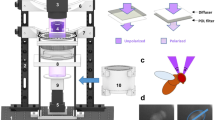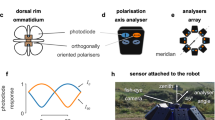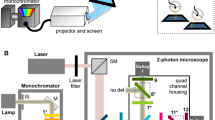Abstract
THE ways in which arthropods, such as bees1–3, ants4,5, Diptera6, insect larvæ7, Cladocera8,9, Amphipoda10 and Decapoda11, orientate in respect to the plane of vibration of polarized light are controversial. Some authors have investigated by optical and electrophysiological means various arthropod eyes and their elements for the properties of an analyser12,13, either those of a Nicol prism or those of some internal reflexion device; whereas others have been more concerned with external visual conditions3 in which orientation to polarized light is observed, and have tried to explain it on the basis of mere brightness discrimination. The present communication has followed the latter approach and was based on the following considerations.
This is a preview of subscription content, access via your institution
Access options
Subscribe to this journal
Receive 51 print issues and online access
$199.00 per year
only $3.90 per issue
Buy this article
- Purchase on Springer Link
- Instant access to full article PDF
Prices may be subject to local taxes which are calculated during checkout
Similar content being viewed by others
References
Von Frisch, K., Naturwiss., 35, 38 (1948).
von Frisch, K., and Lindauer, M., Naturwiss., 41, 245 (1954).
Baylor, E. R., and Smith, F. E., Lecture notes from Woods Hole Oceanographic Institute (1958).
Santschi, F., Mem. Soc. Vaudoise Sci. Nat., 137, 42 (1923).
Vowles, D. M., Nature, 165, 282 (1950).
Wellington, W. G., Nature, 172, 1171 (1953).
Wellington, W. G., Sullivan, C. R., and Green, G. W., Canad. J. Zool., 29, 339 (1951).
Eckert, B., Ceskoslovensk. Biol., 2, 76 (1953).
Baylor, E. R., and Smith, F. E., Amer. Nat., 87, 97 (1953).
Pardi, L., and Papi, F., Naturwiss., 39, 262 (1952).
Kerz, M., Experientia, 6 (1950).
Waterman, T. H., Science, 111, 252 (1950).
Autrum, H., and Stumpf, H., Z. Naturforsch., 56, 116 (1950).
Kalmus, H., Physiol. Comp. Oecol., 1, 127 (1949).
Boehm, G., Acta Ophthalmol., 18, 109, 143 (1940).
Author information
Authors and Affiliations
Rights and permissions
About this article
Cite this article
KALMUS, H. Responses of Insects to Polarized Light in the Presence of Dark Reflecting Surfaces. Nature 182, 1526–1527 (1958). https://doi.org/10.1038/1821526a0
Issue Date:
DOI: https://doi.org/10.1038/1821526a0
This article is cited by
-
10.1007/BF00163650
CrossRef Listing of Deleted DOIs (2011)
-
The discrimination of polarized light by the tarantula
Zeitschrift f�r Vergleichende Physiologie (1966)
-
Polarized light orientation by two Hawaiian decapod cephalopods
Zeitschrift f�r Vergleichende Physiologie (1963)
-
Analysis of Polarized Light by the Bee's Eye
Nature (1961)
-
Interaction of polarized light and turbidity in the orientation of Daphnia and Mysidium
Zeitschrift für vergleichende Physiologie (1960)
Comments
By submitting a comment you agree to abide by our Terms and Community Guidelines. If you find something abusive or that does not comply with our terms or guidelines please flag it as inappropriate.



